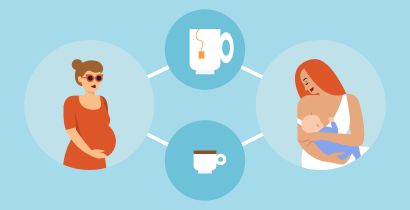The rising concern of gestational diabetes
Last Updated : 30 April 2015Gestational diabetes is a medical condition that occurs during pregnancy. It is rising in prevalence, fuelled mainly by increasing obesity rates and changing lifestyle patterns. Here we look at how this condition occurs, its health implications and how it can be prevented and treated.
What is gestational diabetes?
Gestational diabetes, or gestational diabetes mellitus (GDM) is a medical condition and rising health concern that usually occurs in the second half of pregnancy.1 When a woman has GDM, her blood glucose (sugar) levels become higher than normal. Normally, the insulin hormone reduces the amount of glucose in the blood, for example by helping glucose enter cells in muscles, liver and fat tissue. During pregnancy, there is a higher need for insulin but hormonal changes can make cells less responsive to insulin. Normally, when blood glucose levels rise the pancreas secretes more insulin. However, when the pancreas cannot produce enough insulin to help control blood glucose levels, ‘glucose intolerance’ develops; arising during pregnancy, this is called GDM.
Medical implications
GDM can have medical implications for mother and baby. Glucose passes across the placenta and promotes over-growth of the foetus. Macrosomia is a medical condition, where babies are large for gestational age, i.e. typically a birth weight above 4 to 4.5 kg, which can lead to complicated delivery, including shoulder dystocia (when the baby’s shoulder gets lodged behind the pubic bone during delivery) and delivery-related morbidity.2 GDM is also associated with increased risk of preeclampsia, which can be life-threatening if left untreated.3
Mothers with GDM have a high risk to develop diabetes later in life although diabetes usually goes away after the baby is born, more than 50% of women, who had GDM will develop type 2 diabetes within 5 to 10 years after delivery.4 In addition, infants born to women with GDM also have a higher risk of developing obesity and type 2 diabetes in their lifetime.4 If identified in time, the risks of these complications can be reduced by lifestyle interventions.
Prevalence and risk factors
The prevalence of GDM varies across European populations, ranging between 1.7% and 11.6%, with higher rates in Southern than in Northern and Central Europe.5
The following factors can increase a woman’s risk of developing GDM:6,7
- a body mass index above 30 kg/m2 (obesity),
- a previous pregnancy with GDM or a macrosomic baby,
- a first degree relative with diabetes,
- being of a certain ethnicity e.g. South Asian, black Caribbean or Middle Eastern.6,7
Diagnosis
Screening for GDM is inconsistent across Europe. The World Health Organization (WHO) recommends an oral glucose tolerance test (OGTT) at 24–28 weeks for all women with risk factors for gestational diabetes (or an abnormal fasting or random plasma glucose level).8 In OGTT, blood is tested for glucose when fasted and then two hours after ingesting a glucose drink, typically containing around 75 grams of glucose.
The WHO recently recommended that the diagnosis of GDM should be based on the following values3:
- Fasting plasma glucose levels between 5.1-6.9 mmol/l,
- 1 hour after a 75 gram glucose load, plasma glucose level ≥10 mmol/l,
- 2 hours after a 75 gram glucose load, plasma glucose level 8.5-11 mmol/l.
Prevention and treatment strategies
There are a number of ‘modifiable risk factors’ (those that can be controlled) that can help to reduce GDM risk. These include having a healthy body weight before becoming pregnant, being physically active and eating a healthy, balanced diet that includes plenty of whole grains, lean proteins, oily fish, and polyunsaturated and monounsaturated fats in balance.7,9 Intakes of high glycaemic index (GI) foods and drinks should be kept to a minimum.
Once GDM has been confirmed by an OGTT, ideally referral to a dietitian would be the first treatment strategy. While changes in diet and exercise can help improve the condition, an estimated 70% of women will require additional treatment such as oral hypoglycaemic agents or insulin injections.7 Women with GDM are usually given guidance by health professionals on how to self-monitor their blood sugar levels.
References
- Derbyshire E (2011). Special Cases (pp. 218-240). In Derbyshire E (ed.) Nutrition in the childbearing years. Chichester, UK: John Wiley & Sons.
- Young BC & Ecker JL (2013). Fetal macrosomia and shoulder dystocia in women with gestational diabetes: risks amenable to treatment? Current Diabetes Reports 13(1): 12018.
- WHO (2013). Diagnostic criteria and classification of hyperglycaemia first detected in pregnancy. Geneva, Switzerland: WHO.
- International Diabetes Federation website, Gestational diabetes section.
- Schneider S, Bock C, Wetzel M et al. (2012). The prevalence of gestational diabetes in advanced economies. Journal of Perinatal Medicine 40(5): 511-520.
- International Diabetes Federation website, Risk factors section.
- National Institute for Health Care Excellence (NICE) (2015). Diabetes in pregnancy. Management of diabetes and its complications from preconception to the postnatal period. NICE guideline 3.
- WHO (1999). WHO Consultation: Definition, diagnosis and classification of diabetes mellitus and its complications: Report of a WHO Consultation. Part I: Diagnosis and classification of diabetes mellitus. WHO/NCD/NCS/99.2. Geneva, Switzerland: WHO.
- Zhang C & Ning Y (2011). Effect of dietary and lifestyle factors on the risk of gestational diabetes: review of epidemiologic evidence. American Journal of Clinical Nutrition 94(6 Suppl):1975S-1979S.



